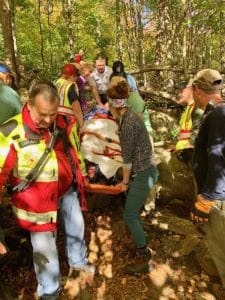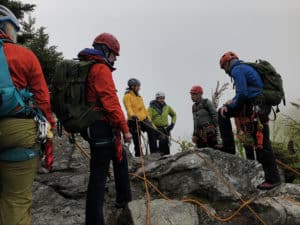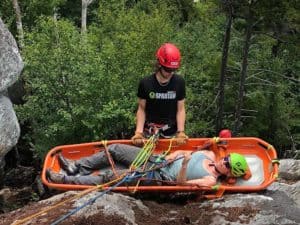Open house scheduled at new Public Safety Building, July 2
By Katy Savage
It was 3:30 a.m. in February when Dave Coppock got a tone from Vermont State Police. A snowboarder was lost in the backcountry of Killington Resort by himself.
The 45-year-old snowboarder had been missing since the day before. It was 15 degrees below zero and easily one of the coldest nights of the year.

Coppock did what he’s done for the past 10 years — he hiked out on snowshoes to find the missing person. “Oftentimes when people are lost back there, it’s kind of predictable where they’ll be,” Coppock said. “But he had moved a lot through the night. The last coordinates we had were out in the middle of nowhere.”
Coppock, who is one of the original members of Killington Search and Rescue (KSAR) , responded to the call with Denise Coriell and Kristen Brodie.
“We went up and found his tracks but they were going in circles,” Coppock said. “We couldn’t tell which was the front of the boot and which was the back. We kept yelling and then half an hour after we found his truck, we heard him yelling back at us.”
Coppock said the snowboarder kept moving through the night, which likely kept him alive.
“I expected him to be in really terrible shape—dehydrated and very cold,” Coppock said.
The team started warming him up with fluids an, to their surprise, he was able to walk out with snowshoes.
“It was all done by the time the sun was coming up,” Coppock said.
Coppock, 66, said those who ski or snowboard out of bounds at Killington tend to end up in the same place— in a steep, swampy brook.
“It’s heinously narrow and then they get stuck down there,” Coppock said. “They think they’ll get back to the ski area. After they’ve skied 1,000 vertical feet, they realize they’re in the wilderness.”

Some end up 20 miles from the Killington Grand Hotel. But Coppock, like other members of Killington Search and Rescue, are used to those kinds of calls.
There are 13 members of KSAR. They go out in all weather conditions, during all seasons.
“I love nothing more than going out in the woods with a compass and a map and trying to find my way to certain places,” he said. “It can be such a rush for the next couple of days, you’re riding a wave of endorphins. You helped somebody; you did this thing that’s exciting. I use all my skills — the things I love the most — that I live for. It’s a gift.”
KSAR is now in its 10-year anniversary. It formed in 2012, just after a 19-year-old Levi Duclos of New Haven was found dead of hypothermia after he went out for a trail run in the winter near Emily Proctor Trail in Ripton. Vermont State Police were notified he was missing the night before but opted to not search for the hiker until the following morning.
The lack of communication led to the creation of a rescue coordinator position within the state Department of Public Safety. Many towns formed their own rescue departments at that time.
“That brought a lot to the forefront,” said Murray McGrath, another founding member of KSAR. KSAR operates under the Killington Fire Department. It was started by a handful of backcountry skiers, like McGrath, who know the Killington terrain well.

McGrath has been skiing the backcountry since the 1970s and was often called out to find lost skiers before KSAR was official.
“I just did a lot of backcountry skiing all through the ’70s and ’80s at Pico and Killington,” he said, and he continues to love it today. “I just love skiing in trees.”
McGrath uses certain landmarks, like trees, and knows if he skis below certain places he can’t get back.
KSAR members now train about once a month and do much more than search for lost skiers. They do high angle rescues for those injured while rock climbing, they find missing hikers in the summer, help injured mountain bikers or ATV riders, find lost children, and respond to just about any type of wilderness rescue.
“It’s a lot more organized now,” McGrath said.
KSAR members bring all the equipment they need with them, like oxygen, a heart defibrillator, headlamps, extra food and warm fluids, something to make fire, extra layers of clothing, and extra snowshoes. For those suffering hypothermia, they have a tarp to wrap individuals in “like a burrito.”
They bushwack through trees and traverse difficult hiking areas. Many of the people they find aren’t prepared for the elements.
“They’re not prepared for spending the night out there,” McGrath said. “They’re not layered with proper clothing. They don’t have any idea where they are.”

The call volume has also increased over the past 10 years with the exploding popularity of exploring the backcountry.
“People are actively searching it out now,” McGrath said.
But members of KSAR are ready for just about any type of call. Some are advanced EMTS, some are land navigators and others are rock climbers.
“My idea of a vacation would be someone else’s worst nightmare,” said Jennifer Robinson, who has been part of KSAR since 2017.
Robinson is a rock climbing instructor who is also trained in avalanche and swift water rescues. Most of her vacations involve summiting rocks and high peaks.
“I’m just out in the woods and out in the mountains,” Robinson said.
Robinson was the point person when a father and his 9-year-old daughter were stuck on the backside of Killington late at night on their snowboards.
KSAR found them quickly and gave them warm, dry clothes to change into and helped them hike out at night. They were most concerned about the young child.
“She was such a trooper,” Robinson said. “It took us probably three hours to hike her out. We kept her mentally as occupied as we could.
“Most people don’t understand we have to physically hike in with all the gear,” Robinson said. “Unless we’re carrying you out, which is a lot of work, you have to walk out on your own. I think a lot of people are surprised by that and they’re surprised by how far it is.”
Denise Coriell, an advanced EMT and wilderness EMT, is an original member of KSAR.
On a summer night in 2019, Corriell led a KSAR team to a call in Wallingford where a hiker on the Appalachian Trail fell and broke his ankle. The team had to carry him out.
“We’ve had a couple of instances where people were afraid to call for help,” Corriell said. “They called a friend and told the friend they were lost and then the friend called 911 to alert us. If you are lost or hurt, you need to call.”

Robert Schlacter, who has been a firefighter for 50 years, leads KSAR.
“They’re people who love the outdoors and love the challenge,” Schlacter said of his fellow KSAR members. “For lack of a better word, that’s their playground. They go up there all the time.”
New Public Safety Building
The police, fire and rescue departments have all grown over the past 10 years. They now operate out of a new 14,000-square-foot building on Killington Road, which was built in 2020.
The building features four bays for fire trucks, with sufficient spacing to back the apparatuses in and out. KSAR uses a 50-foot hose tower at the back corner of the building to practice rope training inside.
“It’s specifically designed for what we want to do,” Schlacter said. “It’s a major improvement for everybody that uses it.”
“It’s working out really well for us,” said Killington Police Chief Whit Montgomery, who also helped found KSAR with Bob Giolito, a former state trooper on the state police search and rescue team.
The building has office areas and a community room with space for training and meetings. It also has a police holding cell. “It allows us to have a home and place for citizens to meet in a professional setting. It keeps officers in town longer if we need to address a situation,” said Montgomery, who was hired as a police officer in 1999 before he became a constable . He was hired as a police chief in 2013.
The goal was for the three organizations to benefit from working collaboratively out of the same building. Over the past 10 years, each has changed and adapted to better meet the need of the community and its visitors— and continues to do. Both organizations have seen an increase in call volume and activations.
Recent KSAR responses
2018- 13 activations
2019 -11 activations
2020 -12 activations
2021 -19 activations
Recent police responses
2018 – 1,585 calls for service
2019 – 1410 calls for service
2020 – 1700 calls for service
2021- 1,690 calls for service
The fire department is now also moving from a volunteer organization to employing a full time chief.
“It’s very difficult to be the chief of the department and have another job,” said Gary Roth, who has been a volunteer chief for 10 years. “The position has grown to the point where it needs to be someone who is more than a volunteer.”
KSAR will likely remain a volunteer organization, Roth and other members said. “There is no plan to omit any of the volunteer people,” Roth said. “The plan is to become a hybrid situation where we work together with the volunteers.”
Roth said part of KSAR’s success has been the commitment and close bond of the members.
“They’re extremely fit, most of them,” Roth said. “They have a lot of energy. ”
An open house at the new public safety building is July 2.




